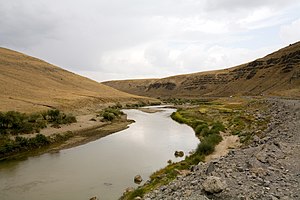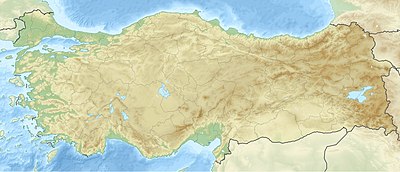Murat River
| Murat River | |
|---|---|
 | |
| Physical characteristics | |
| Mouth | Karasu near Keban, Elazığ Province |
• elevation | 820 m (2,690 ft) |
| Length | 722 km (449 mi) |
| Basin features | |
| River system | Euphrates |
The Murat River (Turkish: Murat Nehri), or Eastern Euphrates is the major source of the Euphrates. The river was called Arsanias (Armenian: Արածանի) in antiquity. It originates near Mount Ararat north of Lake Van, in Eastern Turkey, and flows westward for 722 km (449 mi) through mountainous area. Before construction of the Keban Dam, the Murat River joined the Karasu 10 km (6.2 mi) north the dam site and 13 km (8.1 mi) north the town of Keban.[1]
In Muş Province, the river is interrupted by the Alpaslan-1 Dam which was completed in 2009. In 2016 the Alpaslan-2 Dam is expected to be complete and is located downstream of Alpaslan-1. The river merges into the reservoir of Turkey's once largest dam, the Keban Dam, which was completed in 1974 and is designed to provide electrical power.[2]
Name
The present name is usually connected with the Turkish name Murat or its appellative murat "purpose, intention, desire".
The river was called Arșania in sources of the Neo-Assyrian Empire, and Arsanias in Classical Greek and Roman times. Those forms may derive from an Armenian original (Արածանի Aratsani), itself from an Indo-European root for 'white, bright'.[3][4]
Footnotes
- ^ "Soccer On Frozen River". Turkish Daily News. 2004-12-31.
- ^ "Marat River". Encyclopædia Britannica. Retrieved 2008-02-16.
- ^ Journal of the Society for Armenian Studies. The Society. 2005. p. 33.
- ^ Mario Liverani (1995). Neo-Assyrian geography. Università di Roma, Dipartimento di scienze storiche, archeologiche e antropologiche dell'Antichità. p. 57.
39°24′N 43°45′E / 39.400°N 43.750°E

